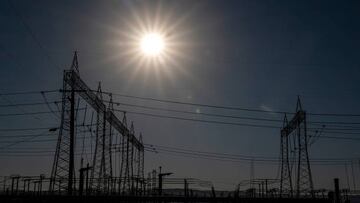Heat wave in California: How long will it last and what will the maximum temperatures be?
The Golden State has been burnt up by a record-breaking heatwave that has left officials contemplating rolling electricity blackouts.


Temperatures in California are expected to reach record levels this week as a heat wave burns across the West Coast of the United States. In recent days dozens of local temperature records have been broken in the state and authorities are battling wildfires, water shortages and electrical outages.
This historic heatwave is expected to push temperature up to 115F (46C) this week, with residents being warned to prepare for possible rolling blackouts. Livermore, for example, recorded a maximum temperature of 116F on Monday, smashing the city’s previous record high of 108F.
“Extreme, dangerous heat gripped much of the region on Monday and numerous official maximum record temperature records were tied or broken,” the National Weather Service (NWS) warned, pointing to 11 daily temperature records being broken in the San Francisco Bay Area alone.
No cooling off yet for the Western U.S., and the Northern Rockies and Central/Northern Plains will heat up as well into the second half of the week. Learn how to stay cool at https://t.co/asAP108BNk pic.twitter.com/RhRXcvG7Ts
— National Weather Service (@NWS) September 6, 2022
California has been subject to a state-wide energy consumption alert for the past seven days and the stifling heatwave is expected to continue until Friday at the earliest. The NWS has noted that areas are currently between 20 and 35 degrees hotter than typical historic levels, with several sites approaching 120F.
Prolonged heatwave brings the risk of energy blackouts
The dangerously high temperatures seen this week have sent many Californians cranking up the air conditioning in their homes and offices, but the state’s grid operator has warned that the system may struggle to keep up with demand.
“We have now entered the most intense phase of this heatwave,” said California Independent System Operator (CAISO) chief, Elliot Mainzer. “Forecasted demand for Monday and Tuesday is at all-time record levels and the potential for rotating outages has increased significantly.”
On Wednesday the peak demand could exceed 51,000 megawatts, surpassing the 50,270 megawatt record set in 2006. If that were to happen then residents may have to contend with rolling blackouts to ensure that the grid is able to service the state’s top priorities, such as healthcare locations.
Here’s a tool to figure out whether your block is scheduled for a rolling blackout today, should one be needed: https://t.co/5pxOykIc94
— Senator Scott Wiener (@Scott_Wiener) September 6, 2022
Losing power would not only prevent residents from using air conditioning and fans to keep themselves cool in the heat, but would also threaten the operation of vital resources. Disabled residents using powered medical devices are a main concern, while children and the elderly are considered at particular risk to heat-related illness.
Related stories
“Outages are a significant inconvenience to those affected, but it’s preferable to manage emergencies in a controlled manner rather than let it cause a wider spread, longer lasting disruption,” reads the CAISO website.
For now the state is content with the voluntary conservation alerts currently in place, but many more days of this heatwave could force officials to take more drastic action.

